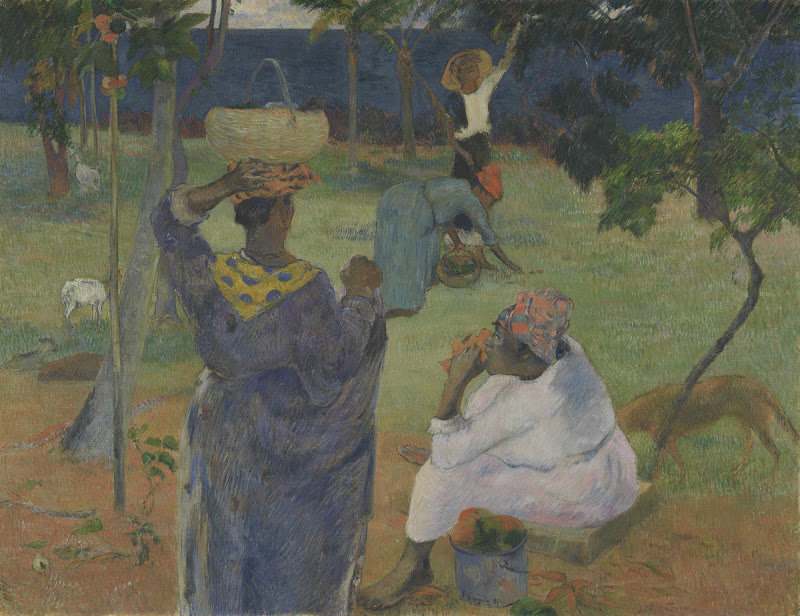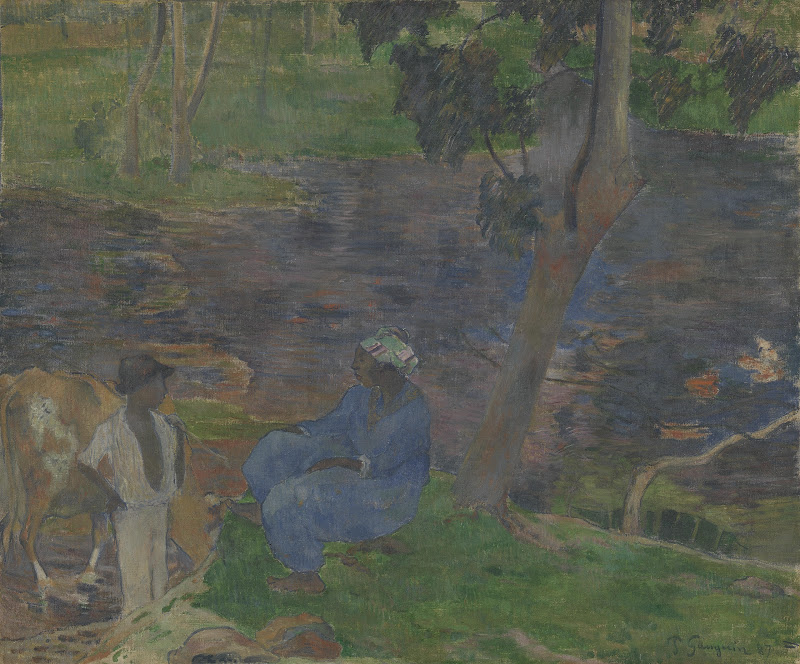5 October 2018 to 13 January 2019
Gauguin & Laval in Martinique is the first ever exhibition devoted to a crucial, but up until now neglected period in the artistic career of Paul Gauguin: the four months that he spent in Martinique in 1887, together with Charles Laval. The colourful, innovative artworks that the two friends created on the island proved to have a huge impact on their artistic development and future careers.
Gauguin & Laval in Martinique unites a large number of the paintings, drawings and sketches that the two French artists created on the Caribbean island for the first time. Many of the loans are part of private collections and are otherwise rarely exhibited or published, if ever at all.
The Van Gogh Museum is home to several significant works by Gauguin and Laval from their Martinican period. Vincent van Gogh and his brother Theo made the initial acquisitions for this collection as early as 1887.
As a part of the exhibition, contemporary artist Jean-François Boclé (1971, Martinique) reflects on the artists’ perceptions of the island with a unique installation.
In search of new art
In 1887, Paul Gauguin (1848-1903) and his lesser-known friend Charles Laval (1861-1894) travelled to Martinique. They hoped to swap what they considered to be the mondaine Parisian life for unspoilt surroundings, and craved a simpler, freer way of life. The two artists were looking for new motifs and inspiration to give their art fresh direction.On the Caribbean island, far from the French mainland, Gauguin and Laval found subjects for new, ‘exotic’ paintings. They drew and painted the island and its people in warm colours, while developing their own styles. They experimented using bold lines, simplified areas of colour and complex compositions. Gauguin composed paintings from elements of sketches and other paintings, which he subsequently forged into new compositions.
In the four months that Gauguin stayed in Martinique and the little under a year that Laval was on the island, the two artists produced more than 20 oil paintings and many more drawings, sketches and elaborate pastel and chalk works.
Back in Paris
Very soon after returning from Martinique, Gauguin met Vincent and Theo van Gogh. The brothers were so impressed by the innovative paintings and drawings that Gauguin had created on the island, that they directly purchased the most important work from the series,
Paul Gauguin (1848 - 1903), Martinique, 1887oil on canvas, 86 cm x 116 cm
Credits Van Gogh Museum, Amsterdam (Vincent van Gogh Foundation)
The Mango Trees, Martinique, for 400 francs: their most expensive ever purchase ever.
This sale was of notable significance to Gauguin and his career. Theo van Gogh later purchased another of Gauguin’s drawings (Head of a Woman from Martinique) and became his regular art dealer, going on to play a considerable role in the promotion of Gauguin’s work.

The brothers added a second painting, On the Banks of the River, Martinique, to their collection in exchange for two of Vincent van Gogh’s Parisian still lifes of sunflowers. Vincent van Gogh was extremely enthusiastic about Gauguin’s works, praising them as ‘high poetry’. The two paintings and the drawing acquired by the Van Gogh brothers have always been in the collection of the family and subsequently, the museum.
A unique exhibition
While Gauguin and Laval’s stay in Martinique marked a crucial phase in their careers and influenced their future oeuvre, this period has always been neglected; an exhibition has never before been devoted to this subject.Gauguin & Laval in Martinique is the first time that a large number of the paintings, drawings and sketches by the artists are being united. Many of the loans are in private collections and are otherwise rarely, or never, exhibited in public – let alone in the Netherlands – or depicted in publications. The exhibition features a total of 81 artworks, 65 of which are on loan from collections in 12 different countries. 16 works from the Van Gogh Museum collection are included in the exhibition.
Gauguin used three sketchbooks in Martinique. Over the years, the sketchbooks were dismantled and the sheets found their way into private and museum collections all around the world. Many of the sheets are now being put on public display for the first time: a large number of sheets from the three sketchbooks were traced and united especially for Gauguin & Laval in Martinique.
Paul Gauguin, 'Martinican Women', 1887, Pencil, black chalk and pastel on paper, 49 × 63.5 cm, private collection
Never before have so many sketches by Gauguin been displayed together. It is also the first time that The Mango Trees, Martinique is being united with its large, elaborate preparatory study in pastel.
Publication
A catalogue accompanies the exhibition, written by Maite van Dijk and Joost van der Hoeven, featuring contributions from Sylvie Crussard and Karen Rechnitzer Pope. The catalogue offers a comprehensive overview of the works that Gauguin and Laval created in Martinique, alongside detailed essays.Following on from the exhibition (the first time that a large number of the Martinican works are being put on display together), further technical examination and international expert meetings, an academic publication will be produced. This publication will unite all of the available knowledge and expertise on the subject from various perspectives and disciplines. The book is expected to be published in 2020.

Self-Portrait with Portrait of Émile Bernard (Les misérables), 1888
Paul Gauguin
Self-Portrait, 1888
Charles Laval
Landscape on Martinique, 1887 - 1888
Charles Laval
Sketch of Several Figures, Flowers and Animal, 1887
Paul Gauguin
Coming and going, Martinique, 1887
Paul Gauguin
Coastal landscape from Martinique (The Bay of Saint-Pierre, Martinique), 1887
Charles Laval Two Women Carrying Baskets on Martinique, 1889
Charles Laval
Women on the Seashore, 1889
Charles Laval
Women on the Seashore, Sketch, 1887-88
Charles LavalPaul Gauguin, 'Martinique Landscape', 1887, Oil on canvas, 117 x 89,8 cm, National Gallery of Scotland, Edinbrugh,, presented by Sir Alexander Maitland in memory of his wife Rosalind 1960